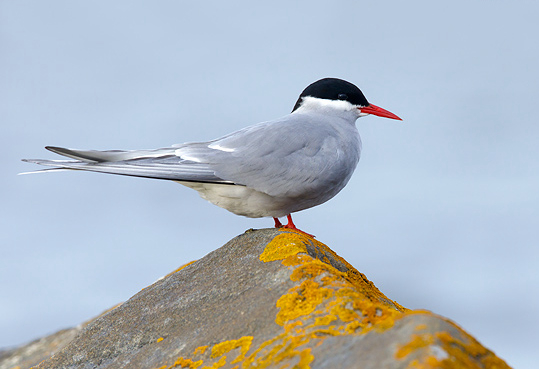
A study of Arctic Terns nesting in Canada revealed the migration routes of these birds to and from their “wintering” range in Antarctic waters (photo by Brian E. Small).
|
Arctic Terns hold the world record for the longest annual migration among birds, flying from nesting sites in the Arctic to feed during winter in Antarctic waters – more than 4,000 miles! According to a new University of British Columbia study, during their long-distance migrations Arctic Terns follow just a few select routes. Each year, Arctic Terns nest in colonies scattered across North America and northern Europe and Asia before they make their long southbound migration, which will begin soon.
While migration patterns of some Arctic Terns that nest in Europe have been tracked, no study had been done on Arctic Terns in Canada or Alaska, which was part of the reason for Joanna Wong’s research, especially considering that Canada has many important nesting sites for the species. “My only expectation for this study was to get a clearer picture of ‘Canadian’ Arctic Tern migration routes,” said Wong, the study’s lead author and a graduate of the Institute for the Oceans and Fisheries (IOF) at the University of British Columbia (UBC). “But when we compared our results to other Arctic Tern tracking studies, it was crazy that there was such a similarity between all of them. It was a pattern that we couldn’t ignore.
Researchers from UBC, along with 8 other universities and research groups from Canada, the United States, and Germany collaborated to capture Arctic Terns, place tracking devices on them, set them free, and analyze an unprecedented amount of collected data.
When migrating south, researchers found that almost all the tagged Arctic Terns took 1 of 3 routes: 2 along the Atlantic Ocean and 1 along the Pacific Ocean. However, when they migrated north, terns stuck to 1 of 2 routes: 1 Atlantic and 1 Pacific. On their southbound journeys, they stayed closer to the coast whereas during their northbound migrations, they flew over the middle of the ocean.
“It’s clear that food is a huge driver when the Arctic Terns take the coastal routes during fall migrations. It makes sense because they’re leaving after nesting, when they use a lot of energy,” Wong explained. “Their northbound migration is influenced by wind. They want to get back to nesting sites as soon as possible because there’s a lot of competition for the best nesting spots.”
Wong and associates hope that by understanding the migration routes used by Arctic Terns, we can better protect the birds and conserve the marine environments they depend on to make their Olympic flights each fall and spring. To refer to the original article published in ScienceDaily, see https://www.sciencedaily.com/releases/2021/08/210805090839.htm